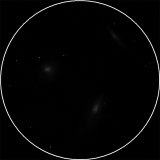
| MESSIER 86 |
|---|
RA: |
12h 26m 12s |
|
DEC: |
+12° 57' 00'' |
|
Type: |
Lenticular galaxy |
|
NGC: |
4406 |
|
Magnitude: |
8.90 |
|
Surface brightness : |
13.20 |
|
Apparent dimensions : |
9.8'x6.3' |
|
Distance: |
60,000,000 ly |
|
M86 has been discovered and cataloged by Charles Messier on March 18, 1781 when he also cataloged 7 more nebulous objects in the same region of the sky, all member galaxies of the Virgo Cluster, and in addition, globular cluster M92. This bright giant galaxy is either an elliptical of type E3 or a lenticular galaxy of type S0. M86 lies well in the heart of the Virgo Cluster of galaxies and forms a most conspicuous group with another giant, M84. This group may be viewed in one field even at medium power, so that it is often photographed. M86, together with M84, can be found rather easily, by pointing your telescope almost exactly half-way between Denebola (Beta Leonis) and Vindemiatrix (Epsilon Virginis). Both galaxies will show up in the same low (or medium) power eyepiece, and can serve as starting point for Observing the Virgo Cluster. Alternatively, you can find M84 and M86 from the "Big T" asterism including 6 Comae Berenices which is near M98, M99, and M100 at 1 deg south and 1.5 deg East of this asterism's "Southern Tip" star. Or both these galaxies are easily found from M87 which is about 1 degree southeast. |
||
VEDRAN VRHOVAC© 2006.-2007. |
